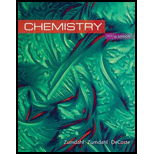
Interpretation: The valence electron configuration for the group
Concept introduction: Group
To determine: The valence electron configuration for group
Trending nowThis is a popular solution!

Chapter 20 Solutions
Chemistry
- Alumina, Al2O3, is amphoteric. Among examples of its amphoteric character are the reactions that occur when Al2O3 is heated strongly or fused with acidic oxides and basic oxides. (a) Write a balanced equation for the reaction of alumina with silica, an acidic oxide, to give aluminum metasilicate, Al2(SiO3)3. (b) Write a balanced equation for the reaction of alumina with the basic oxide CaO to give calcium aluminate, Ca(AlO2)2.arrow_forwardGive the formula for the acidic oxide of (a) HNO3 (b) HNO2 (c) H2SO4arrow_forwardThe amount of sodium hypochlorite in a bleach solution can be determined by using a given volume of bleach to oxidize excess iodide ion to iodine; ClO- is reduced to Cl-. The amount of iodine produced by the redox reaction is determined by titration with sodium thiosulfate, Na2S2O3; I2 is reduced to I-. The sodium thiosulfate is oxidized to sodium tetrathionate, Na2S4O6. In this analysis, potassium iodide was added in excess to 5.00 mL of bleach (d=1.00g/cm3) . If 25.00 mL of 0.0700 M Na2S2O3 was required to reduce all the iodine produced by the bleach back to iodide, what is the mass percent of NaClO in the bleach?arrow_forward
- Halogens combine with one another to produce interhalogens such as BrF3. Sketch a possible molecular structure for this molecule, and decide if the FBrF bond angles will be less than or greater than ideal.arrow_forwardThe reaction of calcium hydride, CaH2, with water can be characterized as a Lewis acid-base reaction: CaH2(s)+2H2O(l)Ca(OH)2(aq)+2H2(g) Identify the Lewis acid and the Lewis base among the reactants. The reaction is also an oxidation-reduction reaction. Identify the oxidizing agent, the reducing agent, and the changes in oxidation number that occur in the reaction.arrow_forward

 ChemistryChemistryISBN:9781305957404Author:Steven S. Zumdahl, Susan A. Zumdahl, Donald J. DeCostePublisher:Cengage Learning
ChemistryChemistryISBN:9781305957404Author:Steven S. Zumdahl, Susan A. Zumdahl, Donald J. DeCostePublisher:Cengage Learning Chemistry: An Atoms First ApproachChemistryISBN:9781305079243Author:Steven S. Zumdahl, Susan A. ZumdahlPublisher:Cengage Learning
Chemistry: An Atoms First ApproachChemistryISBN:9781305079243Author:Steven S. Zumdahl, Susan A. ZumdahlPublisher:Cengage Learning Chemistry & Chemical ReactivityChemistryISBN:9781337399074Author:John C. Kotz, Paul M. Treichel, John Townsend, David TreichelPublisher:Cengage Learning
Chemistry & Chemical ReactivityChemistryISBN:9781337399074Author:John C. Kotz, Paul M. Treichel, John Townsend, David TreichelPublisher:Cengage Learning Chemistry & Chemical ReactivityChemistryISBN:9781133949640Author:John C. Kotz, Paul M. Treichel, John Townsend, David TreichelPublisher:Cengage Learning
Chemistry & Chemical ReactivityChemistryISBN:9781133949640Author:John C. Kotz, Paul M. Treichel, John Townsend, David TreichelPublisher:Cengage Learning Chemistry: Principles and ReactionsChemistryISBN:9781305079373Author:William L. Masterton, Cecile N. HurleyPublisher:Cengage Learning
Chemistry: Principles and ReactionsChemistryISBN:9781305079373Author:William L. Masterton, Cecile N. HurleyPublisher:Cengage Learning





